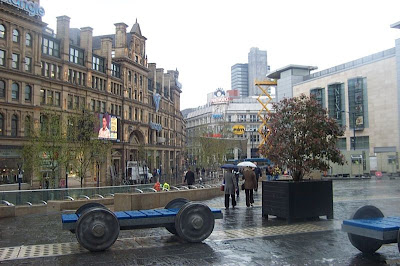It’s not often I hear something that really resonates with the profession of landscape architecture – particularly from one of the major players in the profession. It’s definitely less-often I hear this from Martha Schwartz, whom is better known for edgy design and controversial project aesthetics than sustainability. A recent BBC article offers her surprisingly compelling challenge to landscape architects to grab their rightful place as agents of change. It’s worth a read.

:: Martha Schwartz – image via Archinect
In summary, via the introduction: “The focus on greening homes and offices is ignoring the wider landscape of our towns and cities, argues Martha Schwartz. In this week’s Green Room, she says 21st Century urban spaces must undergo a green revolution.” Schwartz goes on to make her case with some poignant commentary. A few choice cuts (but really, read the whole thing, even you LAs that say you don’t read):
“…I have found that we lag behind architects when it comes to participating in the conversation around sustainability; in fact, we are often relegated to presiding over green roof technology.”
“…The reason for the focus on buildings, as opposed to that of the surrounding landscape, is down to the fact that the uses of resources and energy can be addressed with a degree of simplicity and directness. …Meanwhile, landscape architects are left outside looking in on the discussion because our professional remit rests outside these technologically oriented and building-focused discussions.”
This is a good point, and one that continually comes up in discussions of sustainability and design. A conference I attended yesterday focused so much on sustainable technologies I starting thinking this was the only answer to our problems. The reason – tangible and measurable results. It’s hard to measure landscape architectural benefits to sustainability, much less some of the more intangible aspects of landscape. Continuing on, Schwartz outlines a more holistic viewpoint:
“The landscape is the canvas upon which we live our lives, join together as communities and build our cities. …Embedded and integral to the landscape are the ecological systems that must be understood and respected, as well as the infrastructural systems connecting us all together.”
“Landscape architects ought to help to make cities better places for all who live within them through the establishment of good connectivity and open spaces, the promotion of public transportation and, very importantly, ensuring water is used responsibly, with run-off being managed and put back into the ground. …In addition, landscape architects ought to ensure developers plant as much as possible so that we have an abundance of trees and permeable surfaces.”
Ironically, Schwartz uses a project she designed, Manchester Exchange Square – to make the point of this type design that will acheive this end. While an interesting urban space, it has neither the sustainable design credibility, nor the green open space and abundance of trees to really put to fine a point on the argument. My guess is there’s probably a project or two in her portfolio that create urban greening with more success than this.
:: Manchester Exchange Square – image via Wikipedia
Schwartz goes on to explain that recent activities from PLAN NYC are a step in the right direction, but still lack a vital role for landscape architecture, and more notably, high-design in this process.
“PLAN NYC is certainly a marvellous commitment to improving the lives of citizens by giving them access to fresh, green, open spaces. But it does not push the envelope quite far enough. It does not advocate the vital commitment to landscapes that reflects the most forward visual thinking, through dynamic, inspirational design, and structured attentiveness to community histories. The role of landscape architecture is once again one of green embellishment, adding parks here and there, rather than sustainability agenda-setting through thought-provoking design.”
It’s refreshing to see this candid discussion not just within the community and pages of Landscape Architecture, but happening outside in more mainstream media (ok, it’s not Fox news…). This reduced focus on building and more on urban fabric is not necessarily cutting edge thinking. In some circles it’s called public space design. In others, it’s dubbed landscape urbanism. What is missing is not necessarily the fact, but the underlying reason.

